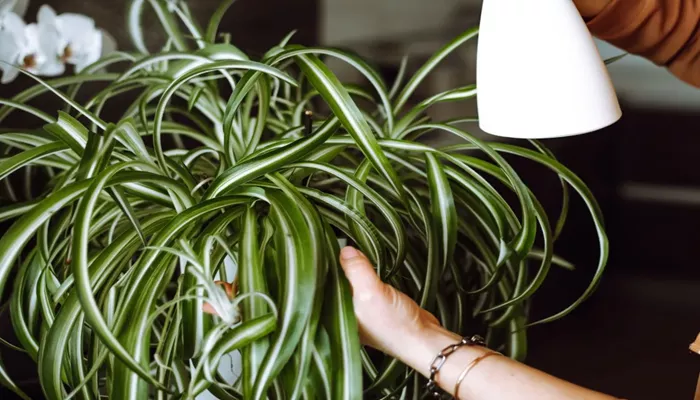Spider Plants: Common Issues and Solutions for Browning Leaves.
If you’re considering adding a spider plant to your home, you’re in good company. These hardy houseplants are popular for their low-maintenance care. However, even the resilient spider plant can face problems, particularly when its leaves start to turn brown. Understanding how to care for a spider plant is essential, even though they are among the easiest houseplants to maintain.
1. Lack of Humidity
Spider plants thrive in humid environments, as they originate from the tropical regions of Australia and Africa. According to Kelly Dyer, an indoor houseplant expert at Patch Plants, inadequate humidity can cause the leaf tips to brown. To address this, you can use a humidifier to increase moisture in the air. Alternatively, placing your spider plant in a naturally humid room like a bathroom or kitchen can help. Another tip from Kelly is to topdress the plant’s soil with a layer of LECA (lightweight expanded clay aggregate) balls to retain moisture.
2. Overwatering
Spider plants generally need watering about once a week. During colder months, they require even less water. Morris Hankinson, Director of Hopes Grove Nurseries, notes that overwatering can lead to root rot, which causes browning leaves. If overwatering has occurred, consider repotting the plant with fresh soil and adding extra drainage holes to the pot.
3. Underwatering
Underwatering can also cause spider plant leaves to turn brown. Morris advises maintaining a balanced watering schedule to prevent the soil from drying out completely before the next watering.
4. Using Tap Water
The type of water used can impact your plant’s health. Luke Dejahang, CEO and Gardening Expert at Crown Pavilions, explains that tap water, with its fluoride content, can cause browning at the leaf tips. Using collected rainwater or distilled water can help avoid this issue, as fluoride and other chemicals in tap water can hinder effective photosynthesis.
5. Excessive Sunlight
Spider plants can suffer from too much direct sunlight, which may scorch the leaves. Despite the UK’s variable weather, if your plant is exposed to intense sunlight, it might get sunburned. To prevent this, move your spider plant to a spot with indirect sunlight.
6. Draughts
Avoid placing your spider plant in draughty areas. Cold draughts from windows or vents can dry out and damage the leaves. Draughty spots are also typically less humid, which further exacerbates the issue.
7. Overfertilizing
Like overwatering, overfertilizing can cause spider plant leaves to turn brown. Morris cautions that excessive fertilizer can lead to toxicity and plant poisoning. Repotting the plant with less fertilizer and fertilizing about once a month can help manage this issue.
8. Diseases
Spider plants can be prone to diseases like root rot, which prevents effective water absorption and causes leaf browning. Ensure your pot has sufficient drainage holes and discard excess water after watering to prevent waterlogging.
9. Pests
Pests such as aphids and spider mites can also affect spider plants. These pests feed on the plant’s sap, leading to browning leaves. Regularly check the plant, especially the undersides of the leaves, for signs of pests. Treatment with a mixture of soap and water or neem oil can help control infestations.
10. Natural Aging
Finally, some browning of leaves may simply be a natural part of the spider plant’s life cycle. Kelly notes that older leaves, typically those at the bottom of the plant, may turn brown as they die off to make way for new growth. It’s perfectly normal to trim these older leaves.
By addressing these common issues, you can keep your spider plant healthy and thriving.


